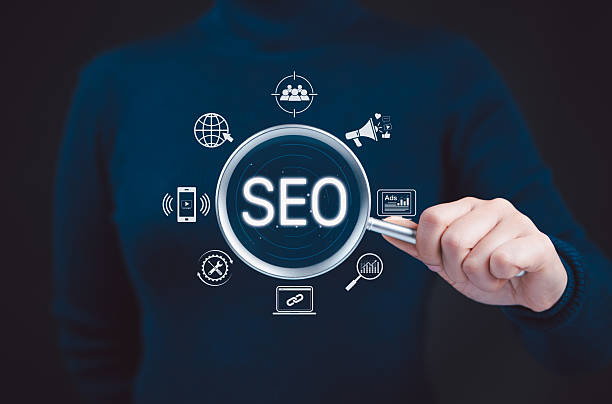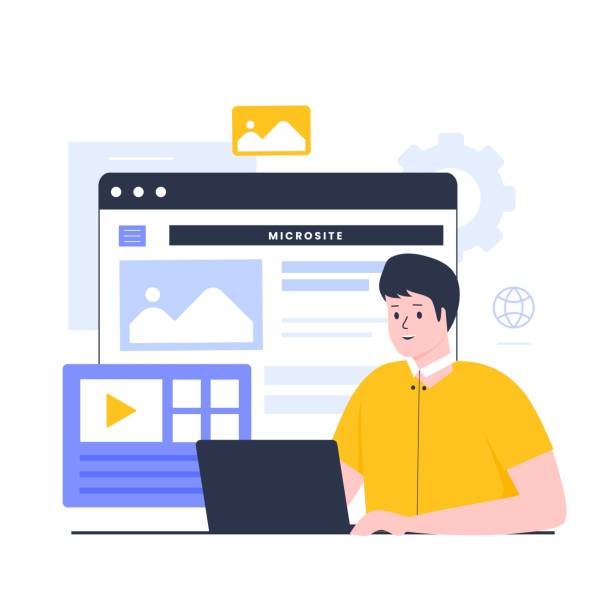Introduction to the World of SEO and Its Importance

In today’s digital world, visibility is vital for every business and website.
This is where the concept of #SEO or Search Engine Optimization comes into play.
SEO refers to a set of actions aimed at improving a website’s ranking in organic search engine results like Google.
Imagine you have a shop on a busy street, but no one knows it exists.
SEO plays exactly the role of your attractive sign and display window in the online world.
This process not only helps increase your website’s traffic but also improves the quality of this traffic, meaning it attracts visitors who are truly interested in your products or services.
The importance of SEO is due to the enormous volume of daily user searches on the Internet; the higher your rank, the more likely you are to be seen and clicked.
This is an educational and continuous process that requires patience and effort.
Understanding the basic principles of #optimization is essential for anyone who intends to succeed in the online space.
Without SEO, even the best content or products may never reach their audience.
This #specialized knowledge is #vital for any online business and opens a door to sustainable success.
This topic goes beyond a simple technique; it is a comprehensive strategy for visibility and effective communication with the audience.
In the following, we will explore various aspects of SEO in more depth.
Did you know that 85% of customers check your company’s website before any interaction?
With RasaWeb, build a corporate website worthy of your credibility.
✅ Increase credibility and customer trust
✅ Attract quality leads
⚡ Get free website design consultation
How Search Engines Work: Principles of Crawling and Ranking

To understand SEO more deeply, we first need to know how search engines work.
The basic operation of search engines is based on three main stages: Crawling, Indexing, and Ranking.
In the crawling phase, search engine robots, also known as crawlers or spiders, scan websites across the Internet.
They follow links, access new pages, and collect their content.
These robots look for new or updated content to keep the search engine’s database constantly updated.
After crawling, the indexing phase begins.
In this stage, the information collected by the crawlers is analyzed and stored in a vast database called the “index.”
This index includes billions of web pages classified by keywords, topics, and other relevant information.
If a page is not in this index, it will never appear in search results.
Finally, the ranking phase takes place.
When a user enters a search query, the search engine uses complex algorithms to examine its index and find the most relevant and high-quality pages.
These algorithms consider more than 200 different factors, including keywords, content quality, page load speed, user experience, backlinks, and domain authority.
The ultimate goal is to provide the best and most accurate results to the user.
Understanding these processes helps us optimize our website in a way that is understandable and trustworthy for search engines, and this is a significant step towards successful SEO.
This is an explanatory and fundamental knowledge for every SEO professional.
Keyword Research: The Backbone of Every SEO Strategy

Keyword research can be considered the backbone of any successful SEO strategy.
This process involves identifying the phrases and words that your target audience enters into search engines to find the information, products, or services they need.
Accurate keyword research helps you create content that directly answers users’ needs and questions and in turn attracts more relevant and high-quality traffic to your website.
This step not only shows you what people are searching for but also reveals the level of competition for those keywords and their search volume.
Various tools are available for keyword research, including Google Keyword Planner, Ahrefs, Semrush, and Moz Keyword Explorer.
Using these tools, you can discover relevant keywords, LSI Keywords (Latent Semantic Indexing Keywords), and Long-Tail Keywords.
Longer keywords, although having lower search volume, are usually more targeted and result in higher conversion rates.
For example, instead of “SEO,” use “SEO training for beginners in Tehran.”
This is a key guideline for effective content creation.
Choosing the right keywords requires a deep understanding of your audience’s needs and your industry.
Also, you should naturally and logically incorporate the keywords you intend to rank for throughout your content, titles, meta descriptions, and URLs.
This part of SEO is truly specialized and requires careful data analysis.
Below is a table for a better understanding of keyword types.
| Keyword Type | Description | Example | User Intent |
|---|---|---|---|
| Short-Tail | 1-2 words, high search volume, high competition, more general | “SEO”, “digital marketing” | Early research phase, awareness |
| Long-Tail | 3+ words, lower search volume, less competition, more targeted | “best SEO methods for online store”, “SEO training course price” | Specific need, ready to buy/act |
| LSI Keywords | Semantically related words, help search engines understand context | For “coffee”: “coffee shop”, “coffee beans”, “espresso” | Comprehensive topic understanding |
On-Page SEO and Content Optimization

On-Page SEO refers to the optimization of various elements inside a web page to improve its ranking in search results.
This process includes techniques and actions that you can directly apply to your website to make it more appealing to search engines and users.
The first and perhaps most important element is the Title Tag.
The title tag should include your main keywords and be attractive and concise enough to encourage users to click.
After that, Meta Description is placed.
Although meta descriptions do not directly impact ranking, they play an important role in click-through rates (CTR) and should briefly describe the page’s content.
Proper use of heading tags (H1, H2, H3, etc.) for structuring content and highlighting key points is also very important.
H1 should contain the main keyword and be used only once per page.
Quality content is the king of on-page SEO.
Your content should be informative, comprehensive, engaging, and relevant to your target keywords.
Ensure natural inclusion of keywords throughout the text and avoid keyword stuffing, as this can harm your ranking.
Optimizing images with descriptive Alt Text and reducing their size for better load speed is also part of on-page SEO.
Internal Links that connect related pages of your website not only help search engines better understand your site’s structure but also improve user experience.
Using short, descriptive, and keyword-rich URLs is also recommended.
Finally, Page Load Speed is one of the important ranking factors; a slow page can deter users and search engines.
On-page SEO is a comprehensive guide for optimizing your site and requires attention to detail.
By following these tips, you can significantly improve your site’s ranking in SEO results.
Does your current website convert visitors into customers, or does it scare them away? Solve this problem forever with professional corporate website design by RasaWeb!
✅ Build credibility and powerful branding
✅ Attract target customers and increase sales
⚡ Get a free consultation right now!
Technical SEO: Hidden but Vital Elements

Technical SEO refers to improving the technical aspects of your website that help search engines crawl, index, and rank your website more effectively.
This part of SEO is often invisible to users but has a significant impact on the site’s overall performance in search results.
One of the most important aspects of technical SEO is site load speed.
Both users and search engines prefer fast pages.
A slowly loading website can lead to an increased bounce rate and a decrease in ranking.
Image optimization, code compression (HTML, CSS, JavaScript), and using Content Delivery Networks (CDNs) are among the solutions for increasing speed.
Mobile-Friendliness is also crucial today, as most searches are conducted via mobile devices.
Google uses a Mobile-First Indexing approach, meaning it considers the mobile version of your site as the primary version for indexing and ranking.
Therefore, ensuring your site’s design is responsive is essential.
Other key aspects of technical SEO include an XML Sitemap, which helps search engines discover and index all important pages of your site, and the Robots.txt file, which tells crawlers which pages they can or cannot crawl.
Fixing crawl errors, improving URL structure, implementing SSL certificates for security (HTTPS), and using structured data (Schema Markup) to help search engines better understand your content are also among the tasks of technical SEO.
Properly performing these can improve user experience and pave the way for better ranking in SEO.
This specialized knowledge is necessary for any website seeking sustainable success.
Off-Page SEO and the Importance of Backlinks

Off-Page SEO refers to actions taken outside your website to improve its ranking in search results.
The most important and influential factor in off-page SEO is backlink building.
A backlink means links that point from other websites to your site.
From a search engine’s perspective, every quality backlink is considered a “vote of confidence” from that website to your content.
The more authoritative and relevant the linking website, the greater the value of that backlink for your SEO.
Quality is preferred over quantity; hundreds of low-quality backlinks from spam sites cannot replace a credible backlink from a site with high Domain Authority and relevance to your field of activity.
Effective strategies for building backlinks include creating very high-quality and valuable content that is naturally linked to by others, connecting with influencers and industry websites, guest posting on relevant blogs, and active presence on social media to increase visibility and content sharing.
In addition to backlinks, social media engagement, online branding, user reviews on review sites, and Q&A platforms can also indirectly affect off-page SEO, as these activities increase your online credibility and popularity.
Remember that backlink building is a time-consuming process and should be done naturally and ethically.
Any attempt to manipulate algorithms through link buying or using link networks can lead to penalties from search engines.
A strong backlink strategy can increase your website’s authority in the eyes of search engines and help you achieve higher rankings in SEO results.
This is a very important guide in the SEO discussion.
Content Creation for SEO: Attracting Valuable Audience

Content, the main fuel of SEO.
Producing high-quality, valuable, and engaging content not only attracts users to your website but also convinces search engines that your site is a credible and reliable source.
There are various types of content, each of which can play a specific role in your SEO strategy.
Blog posts, comprehensive guides, videos, infographics, podcasts, case studies, and even thought-provoking or entertaining content can be effective in attracting and retaining audiences.
When creating content, always keep your target audience in mind.
Answer their questions, solve their problems, and provide information that is truly useful to them.
Your content must be original and unique, and avoid plagiarism.
Natural use of keywords identified in the keyword research phase is highly important.
Longer and more comprehensive content usually performs better in SEO, as it provides more opportunities for deep coverage of a topic and inclusion of relevant keywords.
In addition to content quality, its structure is also crucial.
Using appropriate heading tags, short paragraphs, bulleted lists, and relevant images helps improve readability and user experience.
This structure also helps search engines better understand your content.
Regularly updating old content and adding new information is also an important news and educational strategy that shows your site is dynamic and its information is up-to-date.
Finally, your content should also be optimized for social media sharing to expand its reach.
This is a comprehensive guide for building powerful content.
The table below refers to content types and their SEO goals.
| Content Type | SEO Goal | Example |
|---|---|---|
| Blog Posts | Increase organic traffic, domain authority, lead generation | “How to improve your website’s SEO?” |
| Ultimate Guides | Reference content, attract backlinks, answer deep user questions | “Complete SEO Guide from Zero to Hundred” |
| Infographics | Increase sharing, attract visual backlinks, increase user engagement | “Infographic: 10 Key SEO Steps” |
| Videos | Increase user dwell time, ranking on YouTube and Google Videos | “SEO Tutorial in Simple Language (Video)” |
Local and International SEO: Precise Audience Targeting

SEO is not just about attracting traffic from all over the world; sometimes, the main goal is to attract local customers or target specific markets in other countries.
This is where the concepts of Local SEO and International SEO become important.
Local SEO is crucial for businesses that serve customers in a specific geographical area (such as restaurants, doctors, retail stores).
The main goal of local SEO is to improve your business’s visibility in local search results like “best coffee shop in Isfahan” or “car repair shop near me.”
Key factors in local SEO include optimizing your Google My Business profile, ensuring the accuracy and consistency of NAP (Name, Address, Phone Number) information across all online directories, collecting positive customer reviews, and creating local Landing Pages.
Local SEO can bring highly targeted traffic with high conversion rates, as users performing local searches often intend to make an immediate purchase or visit.
In contrast, International SEO is designed for websites that intend to operate in multiple countries or different geographical regions with different languages.
This type of SEO involves optimizing the website for specific audiences in different parts of the world.
Challenges of international SEO include managing different language versions of the site (using hreflang tags to indicate alternative language versions), choosing the appropriate URL structure for each country (such as country-specific TLDs, subdirectories, or subdomains), and understanding cultural differences and search behaviors in each region.
Also, keyword optimization for each language and region must be done independently.
This is a specialized and analytical approach that requires careful planning to ensure your content is correctly displayed to each target audience worldwide.
Both types of SEO (local and international) require specific strategies for success.
Does your current site display your brand’s credibility as it should? Or does it deter potential customers?
RasaWeb, with years of experience in professional corporate website design, is your comprehensive solution.
✅ A modern, beautiful site consistent with your brand identity
✅ Significant increase in lead generation and new customers
⚡ Contact RasaWeb now for a free corporate website design consultation!
SEO Tools and Performance Analysis: Measurement and Continuous Improvement

Without proper tools, tracking and analyzing website SEO performance is a difficult and almost impossible task.
These tools provide valuable insights into the strengths and weaknesses of your SEO strategy and allow you to make data-driven decisions to improve your ranking.
One of the most important and essential tools is Google Analytics.
This free tool allows you to track your website traffic, identify visitor sources, examine user behavior on the site (such as dwell time and bounce rate), and analyze the conversion path.
Another tool is Google Search Console.
This tool is also free and essential for any website that cares about SEO.
Search Console shows you how your site performs in Google searches, which keywords bring more traffic to your site, whether your site has crawl errors, and reports security or manual issues.
In addition to these basic tools, there are paid and more advanced tools like Ahrefs, Semrush, and Moz that offer wider capabilities in keyword research, backlink analysis (competitor analysis), rank tracking, and technical site health checks.
These tools help you identify thought-provoking or high-traffic content and adjust your strategies accordingly.
Regular use of these tools for performance monitoring, identifying opportunities, and fixing technical issues is essential.
Data analysis helps you optimize your SEO strategy and ensure your efforts are on the right track.
This is an analytical and educational process that must be continuously performed to achieve the best SEO results.
The Future of SEO and Changing Trends

The world of SEO is constantly evolving, and what works today may not be effective tomorrow.
Search engines like Google continuously update their algorithms to provide the best and most relevant results to users.
Therefore, for sustainable success in SEO, it is important to be aware of new trends and adapt to them.
One of the most important future trends is Voice Search.
With the increasing use of voice assistants like Siri, Google Assistant, and Alexa, optimizing for voice search is becoming increasingly important.
Voice searches are usually longer and more conversational, so you need to optimize your content to answer natural questions.
Artificial intelligence (AI) and Machine Learning will also play a significant role in the future of SEO.
Algorithms like Google’s RankBrain use AI to better understand user search intent and provide more accurate results.
This means that focusing on content quality and semantic relevance will become even more important.
User Experience (UX) is also an important factor that search engines are paying more attention to.
Site speed, responsive design, easy navigation, and engaging content all help improve user experience and can indirectly affect SEO.
The rise of Video SEO and optimization for platforms like YouTube is also a growing trend, as video content has gained significant popularity.
For success in the future of SEO, you need to continue producing comprehensive and high-quality content, focus on user experience, and constantly strive to better understand the user’s true search intent.
This is a news and analytical field that requires continuous updates to keep you at the forefront of the competition.
Frequently Asked Questions
| Question | Answer |
|---|---|
| What is SEO? | SEO, or Search Engine Optimization, is the process of increasing the quality and quantity of website traffic by improving the site’s ranking in natural (organic) search engine results like Google. |
| What are the main types of SEO? | SEO is divided into three main categories: On-Page SEO, Off-Page SEO, and Technical SEO. |
| What does On-Page SEO include? | On-Page SEO includes optimizing elements within the website, such as keywords, title tags, meta descriptions, content, URL structure, images, and internal links. |
| What is Off-Page SEO? | Off-Page SEO refers to activities outside the website that help improve its ranking, such as backlink building, social media marketing, and brand mentions. |
| What is Technical SEO? | Technical SEO focuses on optimizing the technical aspects of a website to help search engines crawl and index it better. This includes site speed, mobile-friendliness, site structure, sitemaps, and the Robots.txt file. |
| What role do Keywords play in SEO? | Keywords are phrases that users enter into search engines. Proper and targeted use of relevant keywords in content and site elements helps search engines understand the topic of your page and display it for relevant searches. |
| What is a Backlink and why is it important? | A backlink, or inbound link, is a link from one website to another. Backlinks act as a “vote of confidence” from other sites for search engines and play a significant role in a site’s credibility and ranking improvement, especially if they are from authoritative sites. |
| What impact does quality content have on SEO? | High-quality, relevant, comprehensive, and unique content not only attracts and retains users but also shows search engines that your page is valuable. This helps improve ranking, reduce bounce rate, and increase user dwell time on the site. |
| Why is website load speed important for SEO? | Website load speed is an important ranking factor for Google. Faster sites provide a better user experience, have lower bounce rates, and are preferred by search engines. |
| Is SEO a one-time process? | No, SEO is a continuous and long-term process. Search engine algorithms are constantly changing, competition is increasing, and site content also needs updating. Therefore, SEO requires continuous monitoring, analysis, and optimization. |
And other services of RasaWeb advertising agency in the field of advertising
Smart Customer Journey Map: Professional optimization for digital branding with custom programming.
Smart Social Media: A professional solution to increase click-through rates with a focus on custom programming.
Smart Advertising Campaign: A fast and efficient solution for user interaction with a focus on intelligent data analysis.
Smart Advertising Campaign: Designed for businesses looking to improve SEO ranking through intelligent data analysis.
Smart Digital Advertising: An effective tool for increasing click-through rates with the help of custom programming.
And more than hundreds of other services in the field of internet advertising, advertising consultation, and organizational solutions
Internet Advertising | Advertising Strategy | Advertorials
Sources
Comprehensive SEO Guide, What is SEO?, SEO Tips 2023, SEO Training
? For your business to shine in the digital world, RasaWeb Afarin is with you, offering comprehensive digital marketing solutions including custom website design, SEO optimization, and targeted advertising campaigns. With us, have a powerful and impactful online presence and smooth your path to success.
📍 Tehran, Mirdamad Street, next to Bank Markazi, Southern Kazeroon Alley, Ramin Alley, No. 6


